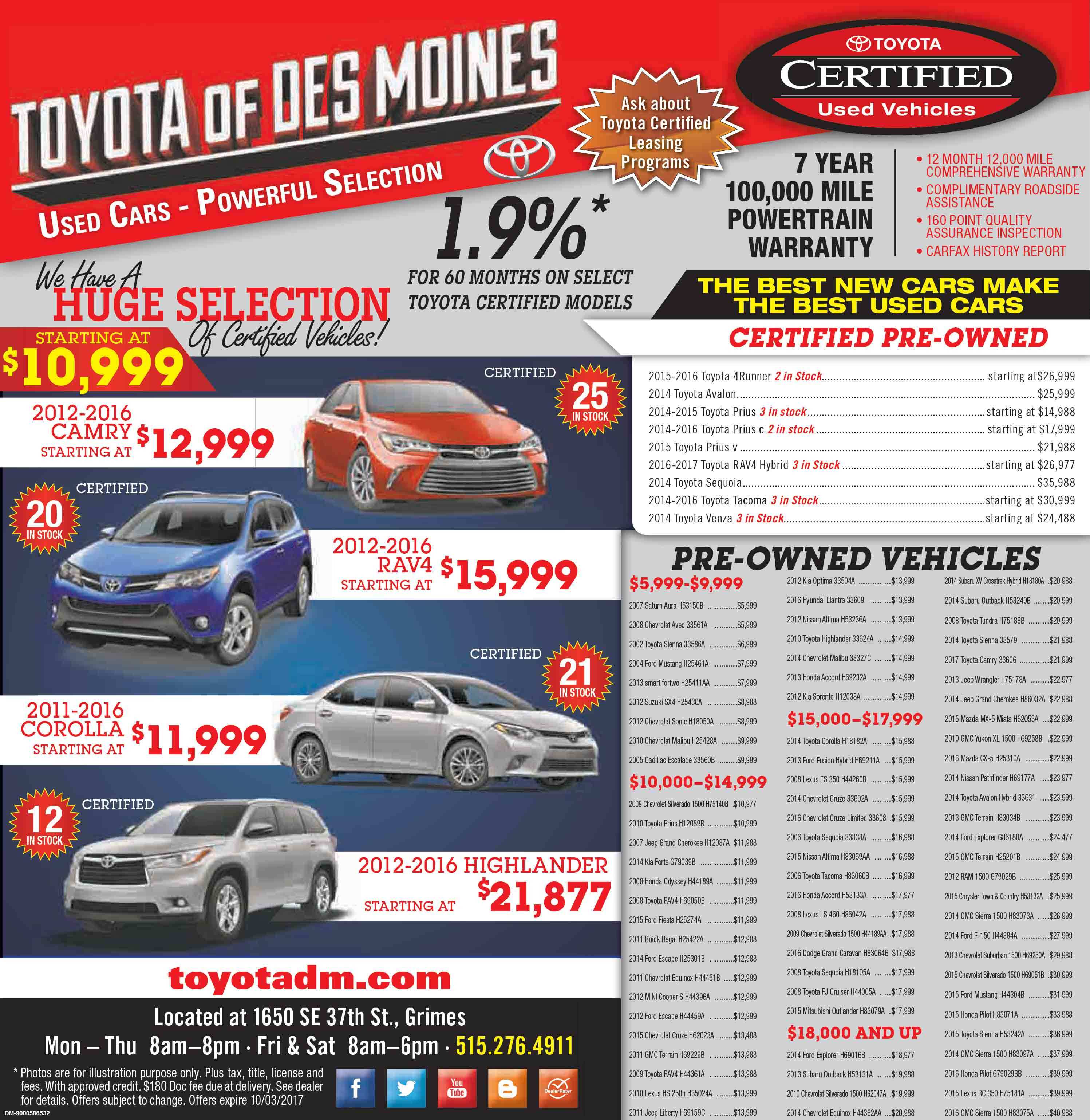
Many innovators at the time took note of the electric vehicle’s high demand, exploring ways to improve the technology. As more people gained access to electricity in the 1910s, it became easier to charge electric cars, adding to their popularity with all walks of life (including some of the “best known and prominent makers of gasoline cars” as a 1911 New York Times article pointed out). They were perfect for short trips around the city, and poor road conditions outside cities meant few cars of any type could venture farther. Electric cars quickly became popular with urban residents - especially women. They were quiet, easy to drive and didn’t emit a smelly pollutant like the other cars of the time. They were also noisy, and their exhaust was unpleasant.Įlectric cars didn’t have any of the issues associated with steam or gasoline.
#Toyota of des monies manual
They required a lot of manual effort to drive - changing gears was no easy task and they needed to be started with a hand crank, making them difficult for some to operate. While gasoline cars had promise, they weren’t without their faults. Steam vehicles required long startup times - sometimes up to 45 minutes in the cold - and would need to be refilled with water, limiting their range.Īs electric vehicles came onto the market, so did a new type of vehicle - the gasoline-powered car - thanks to improvements to the internal combustion engine in the 1800s. Part of this is because steam wasn’t very practical for personal vehicles. Some of the first self-propelled vehicles in the late 1700s relied on steam yet it took until the 1870s for the technology to take hold in cars. Steam was a tried and true energy source, having proved reliable for powering factories and trains.



But as Americans became more prosperous, they turned to the newly invented motor vehicle - available in steam, gasoline or electric versions - to get around. At the turn of the 20th century, the horse was still the primary mode of transportation. To understand the popularity of electric vehicles circa 1900, it is also important to understand the development of the personal vehicle and the other options available. The early rise and fall of the electric car During the next 10 years, they continued to show strong sales. By 1900, electric cars were at their heyday, accounting for around a third of all vehicles on the road. New York City even had a fleet of more than 60 electric taxis. Over the next few years, electric vehicles from different automakers began popping up across the U.S. His six-passenger vehicle capable of a top speed of 14 miles per hour was little more than an electrified wagon, but it helped spark interest in electric vehicles.

Here in the U.S., the first successful electric car made its debut around 1890 thanks to William Morrison, a chemist who lived in Des Moines, Iowa. And while Robert Anderson, a British inventor, developed the first crude electric carriage around this same time, it wasn’t until the second half of the 19th century that French and English inventors built some of the first practical electric cars. In the early part of the century, innovators in Hungary, the Netherlands and the United States - including a blacksmith from Vermont - began toying with the concept of a battery-powered vehicle and created some of the first small-scale electric cars.
#Toyota of des monies series
Instead it was a series of breakthroughs - from the battery to the electric motor - in the 1800s that led to the first electric vehicle on the road. It’s hard to pinpoint the invention of the electric car to one inventor or country. Travel back in time with us as we explore the history of the electric car. With this growing interest in electric vehicles, we are taking a look at where this technology has been and where it’s going. Currently more than 3 percent of new vehicle sales, electric vehicles sales could to grow to nearly 7 percent - or 6.6 million per year - worldwide by 2020, according to a report by Navigant Research. Whether it’s a hybrid, plug-in hybrid or all-electric, the demand for electric drive vehicles will continue to climb as prices drop and consumers look for ways to save money at the pump. Introduced more than 100 years ago, electric cars are seeing a rise in popularity today for many of the same reasons they were first popular.


 0 kommentar(er)
0 kommentar(er)
